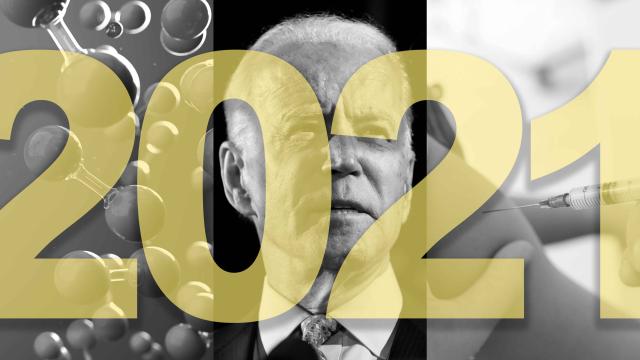
Hydrogen’s future, President-elect Joe Biden and the COVID-19 vaccine. (Source: HartEnergy.com; Alexander Limbach, vasilis asvestas, Tong_stocker/Shutterstock.com)
How it started: Out-of-control global pandemic, Saudi-Russia price war, epic economic collapse, crude price plunge to -$37/bbl, massive layoffs.
How it’s going: Better, but the oil and gas industry will be nursing wounds well into 2021.
“We have been characterizing the oil market at this point going forward as recovering but not recovered,” Mark Finley, fellow at the Center for Energy Studies of Rice University’s Baker Institute for Public Policy, told Hart Energy. Oil remains in the process of coming back from an unprecedented drop in demand, he said, much of it stemming from a near-complete cessation of travel in the late first quarter and early second quarter.
“While [demand is] significantly higher now than it was then, it’s not all the way back nor will it be, most likely, at any point in 2021,” Finley said.
The Fear Factor
The U.S. oil industry endured a gut punch in March 2020 when Saudi Arabia and Russia engaged in a price war just as a world besieged by the COVID-19 pandemic locked itself down. In April 2020, OPEC and its partners, including Russia, agreed to its biggest coordinated production cuts ever. The effort succeeded because of what Finley termed “spectacularly good discipline.”

OPEC’s action has resulted in a sharp reduction in oil inventories, which were near overflow in the spring, Finley said. But the question is: can the members continue to hold the line? The early December ministerial meeting ended with a decision to raise production by 500,000 bbl/d, a compromise between Saudi Arabia, which opposed any increase, and Russia and the United Arab Emirates, which wanted to boost output by 2 MMbbl/d.
“They seem like they’re continuing to work together successfully to hold supply off the market, to keep drawing on inventories,” Finley said. “But we’re starting to see some cracks emerge in the façade.”
Robert Johnston, managing director of the Eurasia Group, made a similar observation, noting that the Saudis would prefer to err on the side of higher prices than lower prices.
“Their concern would be, if you bring back too much crude too quickly, before the market’s really ready for it, you get into a stock build again and lower prices, which they really don’t want,” he said during KPMG’s ENRich 2020: The Net Zero Future online conference in early December.
The Russians, in particular, are leery of higher prices because of how they could incentivize the U.S. shale industry to get back into the game, Finley said. Whether those fears are valid is another matter.
“To the degree that the Russians are basing their fears about the U.S. on the U.S. shale industry in 2017 and ’18,” he said, “they might be a little too scared, frankly.”
The productivity gains of the past just aren’t there anymore, Finley said, and companies are under much more pressure to return cash flow to shareholders rather than spending it. And that doesn’t even take into account growing concerns about the policy and regulatory environment, climate action and ESG-focused investors.

Mike Blankenship, Houston-based partner in Winston & Strawn LLP’s energy practice, said he anticipates a rise in WTI to the $55-$60 range in 2021, a solid boost from the mid-$40s in December.
“This will be in response to deployment of the COVID vaccine and the normalization of demand as we return to a new normal,” Blankenship told Hart Energy. “I think you will still see people continue to work from home, but I think you’re going to start seeing people in Q1, Q2 probably come back to the office and therefore there will be more demand for oil.
“But production will continue to decline across all plays as capital investment gets pulled back and operators start focusing on producing positive cash flow,” he said.
The Biden Factor
The outcome of Georgia’s two runoff races for Senate on Jan. 5 could determine much of what the incoming administration of President-elect Joe Biden will be able to accomplish, particularly in terms of his climate change agenda. Republicans will retain their majority in the Senate if their candidates win one or both of the races. Democrats would have to win both to gain a 50:50 tie and potential control of the chamber (with Vice President Kamala Harris able to cast tie-breaking votes).
Polling as of Dec. 11 showed Democrat Jon Ossoff leading Sen. David Perdue in the Senate election and the Rev. Raphael Warnock ahead of Sen. Kelly Loeffler in the special election. The leads were so small as to be statistically insignificant.
But even if the two Democrats prevail, the elections’ results may not necessarily yield easy wins for Biden in Congress. Local politics plays a significant role in legislative issues, Finley said, and there are mixes of red and blue representation across the shale map.
“With a Republican Senate or one where it’s hard to get a bipartisan consensus on something, then the president is left with administrative orders,” he said. While it might be tempting to satisfy the progressive wing of the Democratic Party in the short run, executive orders are less comprehensive and less durable than legislation and can be overturned easily by the next president.
Biden can fulfill one promise immediately after taking office—he can return the U.S. to the Paris climate agreement—but even that is complicated.
“The question will be, can Biden really deliver a credible plan, given the Republican opposition in the Senate?” Johnston asked. “I think the Europeans, the Chinese and others will look closely at what the U.S. can actually deliver on the next phase of its national contribution.”
Johnston also noted that Biden’s $2 trillion green stimulus, or at least parts of it, might have potential for Republican support. The wind industry is big in Texas, a Republican state, and solar has a large presence in red states like Florida and North Carolina.,
Johnston said he expects pushback from Republicans if Biden follows through on his pledge to ban fracking on federal lands, but Finley notes that most of the onshore action is not on federal lands, anyway. He anticipates Biden will reinstate methane rules for new facilities to the Clean Air Act, where environmental groups are pushing for quick action.
Blankenship did not express concern that oil and gas executives will lose much sleep over the change in administrations.
“I believe the Biden administration’s approach to fossil fuels will probably remain balanced,” he said. “I think we’ll not see any immediate impact. I think the industry remains resilient and open to further investment in other energy sources, especially if there’s a business case for it.”
The Future Factor
That might be the point where oil and gas players become unnerved: How will the Biden administration proceed with the energy transition? And what kind of role should the industry play?
“There’s a huge risk in governments picking winners and subsidizing parts of the economy that are really not the consumer desires, nor are they the more economic outcomes that are needed for companies to be able to invest in technologies,” said Melody Meyer, former senior executive with Chevron Corp. and now a board member with BP, during the KPMG conference.
Subsidies have their role in supporting infrastructure, she said, but “Let the market work and let corporations respond in a way that will accelerate this transition.”
In Johnston’s view, corporations need clear policy signals from government before they feel sufficiently confident to deploy capital.
“You think about the rise of solar power,” he said. “The subsidies were so important early on, and at the time, 15 or 20 years ago, solar was considered wildly uneconomic but now it’s highly competitive in many parts of the world.
“I wonder if that same process will take place with hydrogen, for example, which seems preposterous today but may well be a critical part of the energy transition according to most long-term climate models.”
But it’s not just public money that is driving the transition. Blankenship, who focuses on oil and gas corporate finance and M&A, is seeing private investment interest.
“I think we’re starting to see a lot of the transition to hydrogen,” he said. “I speak to a lot of private equity on other sources, not just renewable, not just solar, wind. There’s definitely a money push into ESG-friendly investments and, whether it be a carbon-capture type business, whether it be some way of converting waste to some other product, whether it will be a power play, we will see.”
Small and mid-size operators may have an advantage over larger competitors that may not be as nimble, Blankenship said.
“I really think that they should continue to evaluate the market and focus on building technical and financial relationships with the goal of really identifying the next opportunity,” he said.
The Transition Factor
Ignoring the reality of the energy transition is not an option for oil and gas companies that wish to survive.
“I believe my advice would be, don’t become the coal industry,” Jennifer Holmgren, CEO of LanzaTech, a carbon recycling technology company, said during the KPMG event. “Divestment movements and all of these things are real and are happening and I think it’s really important to be eyes wide open.”
Larger companies in the oil and gas industry are already on board, Finley said.
“They see that smart regulation of natural gas flaring and venting actually could help prospects for natural gas production,” he said. The overall climate impact advantage of natural gas vs. coal erodes quickly with just a few percentage points of fugitive methane emissions because methane is a much more potent greenhouse gas.
But how will smaller independents manage the transition? Here, it’s a little bit more difficult, Blankenship said.
“They don’t have the capital to transition unless they get a backer from some other line of business,” he said. “Maybe that oil producer can use its surface leases and monetize by leasing out to wind farms and solar farms. I think the smaller folks are going to have to roll up a little bit to get some scale to be able to do anything. Before they do that, they’re going to have to make sure their balance sheets are clean, as in, not a huge leverage ratio.”
Finley sees the challenges for small operators, too.
“I understand that life is tough right now,” he said. “We’ve just come through the worst economic downturn that any of us have lived through and the national unemployment rate is very high, jobs in the oil and gas patch have been hit hard. But at the same time, the movement toward more stringent regulations to deal with the challenge of climate change is inevitable and inexorable.”
Already, he noted, European governments are pressuring companies like Engie to turn away purchases of U.S. LNG specifically because of venting and flaring issues involved with gas production.
“The bottom line is, it’s actually probably good for the industry’s survival if it can be managed in a smart way,” Finley said. “This is a good thing, even longer-term, for the industry to be inside the regulatory regime rather than outside it.”
Recommended Reading
EQT Sees Clear Path to $5B in Potential Divestments
2024-04-24 - EQT Corp. executives said that an April deal with Equinor has been a catalyst for talks with potential buyers as the company looks to shed debt for its Equitrans Midstream acquisition.
Matador Hoards Dry Powder for Potential M&A, Adds Delaware Acreage
2024-04-24 - Delaware-focused E&P Matador Resources is growing oil production, expanding midstream capacity, keeping debt low and hunting for M&A opportunities.
TotalEnergies, Vanguard Renewables Form RNG JV in US
2024-04-24 - Total Energies and Vanguard Renewable’s equally owned joint venture initially aims to advance 10 RNG projects into construction during the next 12 months.
Ithaca Energy to Buy Eni's UK Assets in $938MM North Sea Deal
2024-04-23 - Eni, one of Italy's biggest energy companies, will transfer its U.K. business in exchange for 38.5% of Ithaca's share capital, while the existing Ithaca Energy shareholders will own the remaining 61.5% of the combined group.
EIG’s MidOcean Closes Purchase of 20% Stake in Peru LNG
2024-04-23 - MidOcean Energy’s deal for SK Earthon’s Peru LNG follows a March deal to purchase Tokyo Gas’ LNG interests in Australia.





